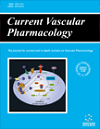- Home
- A-Z Publications
- Current Vascular Pharmacology
- Previous Issues
- Volume 17, Issue 3, 2019
Current Vascular Pharmacology - Volume 17, Issue 3, 2019
Volume 17, Issue 3, 2019
-
-
Statins: Pharmacokinetics, Pharmacodynamics and Cost-Effectiveness Analysis
More LessAuthors: Gabriella Ricci, Marco M. Ciccone, Paola Giordano and Francesca CorteseCardiovascular diseases secondary to atherosclerosis are the primary causes of early death and disability worldwide and dyslipidaemia represents one of the most important modifiable risk factors. Among lipid abnormalities that define it, low-density lipoprotein cholesterol (LDL-C) is the primary target of therapy, since multiple randomized controlled trials have shown the positive impact of its reduction on atherosclerosis develop Read More
-
-
-
The Pleiotropic Effects of Statins – From Coronary Artery Disease and Stroke to Atrial Fibrillation and Ventricular Tachyarrhythmia
More LessAuthors: Adam Oesterle and James K. LiaoStatins, 3-hydroxy-methylglutaryl coenzyme A reductase inhibitors, have been used for decades for the prevention of coronary artery disease and stroke. They act primarily by lowering serum cholesterol through the inhibition of cholesterol synthesis in the liver, which results in the upregulation of low-density lipoprotein receptors in the liver. This results in the removal of low-density lipoproteincholesterol. Studies have suggested Read More
-
-
-
Statins and Elderly: From Clinical Trials to Daily Practice
More LessAuthors: Monica Verdoia, Gennaro Galasso, Pasquale P. Filardi and Giuseppe De LucaElderly patients represent a rising social problem, due to the exponential growth of persons in these age groups and their atherothrombotic burden. The management of this population still raises several challenges, requiring a balance between elevated cardiovascular risk, clinical complexity, frailty and co-morbidities. Statins represent the main pillar in cardiovascular prevention, lowering serum cholesterol and reducing morta Read More
-
-
-
Pleiotropic Effects of Statins: Untapped Potential for Statin Pharmacotherapy
More LessAuthors: S. Mohammad, H. Nguyen, M. Nguyen, M. Abdel-Rasoul, V. Nguyen, C.D. Nguyen, K.T. Nguyen, L. Li and J.P. KitzmillerBackground: Statins are effective for primary and secondary prevention of atherosclerotic cardiovascular disease. They also have systemic anti-inflammatory and immunomodulating properties suggesting potential utility for improving clinical outcomes for a wide range of diseases. The literature provides data suggesting benefit in patients with comorbidities associated with contrast-induced nephropathy (CIN), chronic ob Read More
-
-
-
Anti-Angiogenic Activity of Curcumin in Cancer Therapy: A Narrative Review
More LessAuthors: Abolfazl Shakeri, Natalie Ward, Yunes Panahi and Amirhossein SahebkarCurcumin is a naturally occurring polyphenol isolated from Curcuma longa that has various pharmacological activities, including, anti-inflammatory, anti-oxidant and anti-cancer properties. The anticancer effect of curcumin is attributed to activation of apoptotic pathways in cancer cells, as well as inhibition of inflammation and angiogenesis in the tumour microenvironment and suppression of tumour metastasis. Angiogenesis, w Read More
-
-
-
Non-Traditional Cardiovascular Risk Markers in the Era of Established Major Risk Factors and Multiple Guidelines
More LessThe non-traditional cardiovascular (CV) risk factors that appear to be of most clinical interest include: apolipoprotein A (ApoA), apolipoprotein B (ApoB), high-sensitivity C-Reactive protein (hsCRP), homocysteine, interleukin 1 (IL1), lipoprotein (a) [Lp(a)], the density of low-density lipoprotein (LDL) particles, the LDL particle number, tissue/tumor necrosis factor-α (TNF-α) and uric acid. These non-traditional risk factors may be Read More
-
-
-
The Role of Percutaneous Coronary Intervention in the Treatment of Chronic Total Occlusions: Rationale and Review of the Literature
More LessBackground: Chronic total occlusion (CTO) of a coronary artery is defined as an occluded segment with no antegrade flow and a known or estimated duration of at least 12 weeks. Objective: We considered the current literature describing the indications and clinical outcomes for denovo CTO- percutaneous coronary intervention (PCI), and discuss the role of CTO-PCI and future directions for this procedure. Methods: Data Read More
-
-
-
The Significance of Pain in Chronic Venous Disease and its Medical Treatment
More LessAuthors: Djordje Radak, Igor Atanasijević, Mihailo Nešković and Esma IsenovicChronic venous disease (CVeD) is a highly prevalent condition in the general population, and it has a significant impact on quality of life. While it is usually manifested by obvious signs, such as varicose veins and venous ulcers, other symptoms of the disease are less specific. Among the other symptoms, which include heaviness, swelling, muscle cramps and restless legs, pain is the symptom that most frequently compels CVeD Read More
-
-
-
Effects of Intensive Blood Pressure Control in Patients with Evident Cardiovascular Disease: An Investigation Using the SPRINT Study Data
More LessBackground: Recent data advocate adoption of a more intensive treatment strategy for management of blood pressure (BP). Objective: We investigated whether the overall effects of the Systolic Blood Pressure Intervention Trial (SPRINT) are applicable to cardiovascular disease (CVD) patients. Methods: In a post hoc analysis we analyzed data from SPRINT that randomly assigned 9361 individuals to a systolic BP (SBP) t Read More
-
-
-
Involvement of PI3K, Akt and RhoA in Oestradiol Regulation of Cardiac iNOS Expression
More LessBackground: Oestradiol is an important regulatory factor with several positive effects on the cardiovascular (CV) system. We evaluated the molecular mechanism of the in vivo effects of oestradiol on the regulation of cardiac inducible nitric oxide (NO) synthase (iNOS) expression and activity. Methods: Male Wistar rats were treated with oestradiol (40 mg/kg, intraperitoneally) and after 24 h the animals were sacrificed. Read More
-
Volumes & issues
-
Volume 23 (2025)
-
Volume 22 (2024)
-
Volume 21 (2023)
-
Volume 20 (2022)
-
Volume 19 (2021)
-
Volume 18 (2020)
-
Volume 17 (2019)
-
Volume 16 (2018)
-
Volume 15 (2017)
-
Volume 14 (2016)
-
Volume 13 (2015)
-
Volume 12 (2014)
-
Volume 11 (2013)
-
Volume 10 (2012)
-
Volume 9 (2011)
-
Volume 8 (2010)
-
Volume 7 (2009)
-
Volume 6 (2008)
-
Volume 5 (2007)
-
Volume 4 (2006)
-
Volume 3 (2005)
-
Volume 2 (2004)
-
Volume 1 (2003)
Most Read This Month
Article
content/journals/cvp
Journal
10
5
false
en


